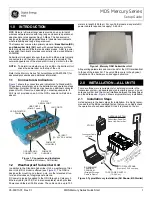
Page 9
HUGO SACHS ELEKTRONIK - HARVARD
A P P A R A T U S
GmbH D-79232 March-Hugstetten Germany
HSE PLUGSYS
®
TAM-A Type 705/1 and TAM-D Type 705/2
4.2.5 Autozero coupling (jumper J8).
Automatic zeroing (autozero) operates digitally with a resolution of 12 bit. This represents an adjustment range
of 4096 steps (±2048 steps). Zero adjustment operates directly on the amplifier input so that the zero shift per
step depends on the internal resistance of the transducer and on the gain setting. As a basic setting the jumper
J8 has to be placed in position (B) (medium).
In case zeroing presents low accuracy (large zero shift per step), at a very large gain setting or at a high
transducer resistance (internal resistance greater than 1 kOhm) the position A (low) should be selected. This
reduces the effectiveness of the autozero function, there is a smaller zero shift per step.
By contrast it is possible with low gain and low transducer resistance (internal resistance 100 - 500 Ohm) that
the autozero adjustment range is not sufficient. The autozero effect must then be increased, jumper in position
C (high). This results in a larger zero shift per step and therefore also a larger autozero adjustment range.
Jumper J4 assigns to the monitoring output on the front (BNC socket) either the pulsatile
or the mean value output.
In order to see the real unfiltered signal, n
ormally the pulsatile output
should be selected. On the TAM-A the measured signal then corresponds to the signal
course on the bargraph.
When using the mean value output at the BNC socket the output signal is no longer identical with
the phasic wafeform of the measured signal. This may erroneously be considered
as a fault on the output.
4.2.7 BNC socket Pulsatile or Mean output (jumper J4)
Warning
4.2.8 Internal signal outputs PULSE and MEAN (jumper J5)
The internal signal outputs PULSE and MEAN of the TAM are each assigned by a jumper on the link connector
J5 to an analogue bus line (AV1 - AV16).
Be sure to select an AV bus line which is not in use and is therefore free. Duplicate connection
causes short-circuiting of the two signal outputs. Details of the AV lines already being used in the
system can be taken from the bus diagram of the PLUGSYS housing. See chapter 1
of the white operating instructions folder (delivered with each housing).
If there is no bus diagram it is unfortunately necessary that the settings on your
system are determined again. For that purpose all the modules have to be removed
in turn and the AV circuit arrangement set on them has to be checked and written down.
Warning
The diagram in Section 4.2.2 illustrates at (A) the assignment of the PULSE output to AV-1 and that of the
MEAN output to AV-2. It is not essential to use both signal outputs, and the jumpers can then be stored safely
on the outer pin rows as shown at (B) (parking position). In this position the jumper is ineffective.
The AV setting which you have made on the TAM must be documented in the bus
diagram of the housing.
Important
4.2.6 Low pass filter setting mean output MEAN (jumper J3)
The time constant (filter action) of the MEAN signal output of the TAM can be set to 0.1 or 0.3 Hz. 0.1 Hz should
be selected as the basic setting. This provides maximum smoothing of the pulsatile signal (e.g. blood pressure
trace). The mean value (mean pressure) can then be obtained at the MEAN signal output. In view of the large
time constant of 10 seconds in position 0.1 Hz, signal changes at the MEAN output can only be measured
correctly if the measurement signal changes take place more slowly than 0.1 Hz. Otherwise part of the averaged
signal is suppressed in addition to the pulsatile signal. In that case the mean value filter must be set to 0.3 Hz
(3.3 seconds).










































